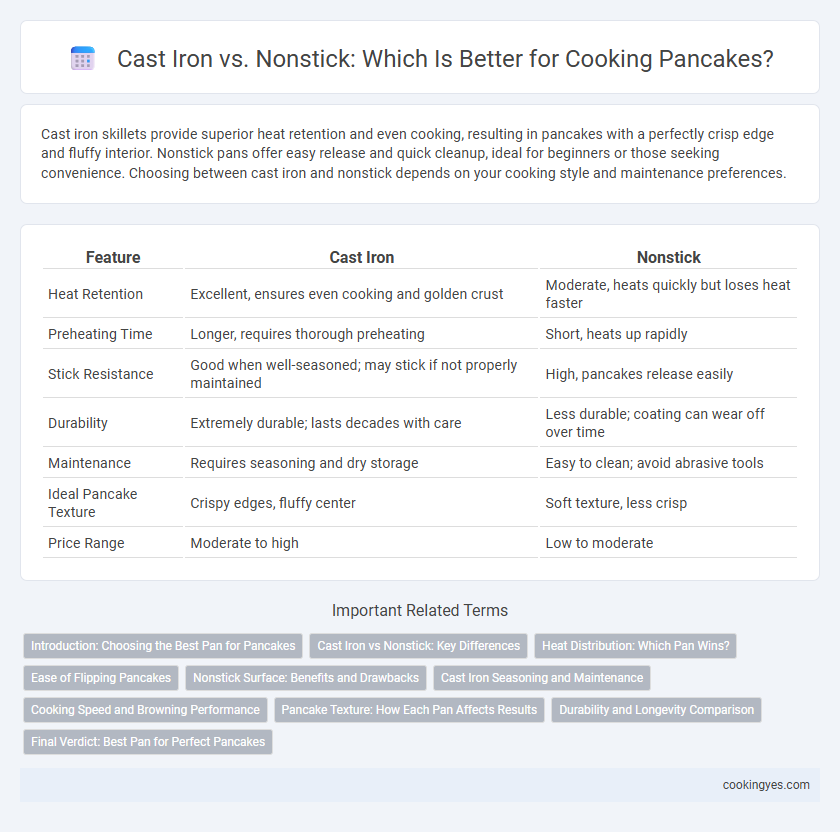Cast iron skillets provide superior heat retention and even cooking, resulting in pancakes with a perfectly crisp edge and fluffy interior. Nonstick pans offer easy release and quick cleanup, ideal for beginners or those seeking convenience. Choosing between cast iron and nonstick depends on your cooking style and maintenance preferences.
Table of Comparison
| Feature | Cast Iron | Nonstick |
|---|---|---|
| Heat Retention | Excellent, ensures even cooking and golden crust | Moderate, heats quickly but loses heat faster |
| Preheating Time | Longer, requires thorough preheating | Short, heats up rapidly |
| Stick Resistance | Good when well-seasoned; may stick if not properly maintained | High, pancakes release easily |
| Durability | Extremely durable; lasts decades with care | Less durable; coating can wear off over time |
| Maintenance | Requires seasoning and dry storage | Easy to clean; avoid abrasive tools |
| Ideal Pancake Texture | Crispy edges, fluffy center | Soft texture, less crisp |
| Price Range | Moderate to high | Low to moderate |
Introduction: Choosing the Best Pan for Pancakes
Cast iron pans provide superior heat retention and even cooking, essential for achieving golden-brown, fluffy pancakes with crispy edges. Nonstick pans offer convenience with easier flipping and minimal oil usage, ideal for quick and low-fat pancake preparation. Selecting between cast iron and nonstick depends on desired texture, cooking experience, and maintenance preferences.
Cast Iron vs Nonstick: Key Differences
Cast iron pans provide superior heat retention and even distribution, essential for achieving a perfectly golden, crispy pancake crust, while nonstick pans offer easy release and minimal oil usage for a lighter cooking experience. Cast iron requires seasoning and maintenance to prevent rust and maintain its nonstick properties, whereas nonstick pans feature synthetic coatings that can degrade over time and may release harmful chemicals at high temperatures. Choosing between cast iron and nonstick depends on balancing durability, cooking performance, and ease of cleaning for optimal pancake results.
Heat Distribution: Which Pan Wins?
Cast iron skillets provide superior heat retention and even heat distribution, ensuring pancakes cook uniformly with a crispy, golden-brown crust. Nonstick pans heat up quickly but often exhibit uneven heat distribution, which can lead to inconsistent pancake texture and browning. For precision and consistent results in pancake cooking, cast iron is the preferred choice due to its optimal thermal conductivity and heat retention.
Ease of Flipping Pancakes
Cast iron skillets provide excellent heat retention and a naturally nonstick surface when properly seasoned, making pancake flipping easier and more precise. Nonstick pans offer immediate effortless release, ideal for delicate pancakes, but may wear down quickly with frequent use. For consistent pancake flipping, cast iron balances durability and performance, whereas nonstick excels in convenience and low maintenance.
Nonstick Surface: Benefits and Drawbacks
Nonstick surfaces offer even heat distribution and easy pancake flipping, reducing the need for excessive oil or butter and promoting healthier cooking. However, nonstick coatings can be prone to scratching and deterioration, requiring careful use of non-metal utensils and lower cooking temperatures to maintain their longevity. Despite these limitations, nonstick pans provide convenient cleanup and consistent pancake texture, making them a popular choice for everyday use.
Cast Iron Seasoning and Maintenance
Cast iron skillets provide superior heat retention for even pancake cooking, but require proper seasoning to maintain their natural nonstick surface. Seasoning involves coating the skillet with oil and heating it to create a durable, polymerized layer that prevents sticking and protects against rust. Regular maintenance includes avoiding soap, drying thoroughly, and reapplying oil after each use to ensure longevity and optimal pancake flipping performance.
Cooking Speed and Browning Performance
Cast iron pans provide superior heat retention, resulting in even cooking and better browning performance for pancakes, producing a crispy exterior and fluffy interior. Nonstick pans heat up quickly, allowing faster cooking speed but may lack the high-heat tolerance required for optimal browning. Choosing cast iron enhances caramelization and texture, while nonstick offers convenience and speed with less precision in color development.
Pancake Texture: How Each Pan Affects Results
Cast iron pans create pancakes with a crispier, golden-brown exterior due to their superior heat retention and even cooking surface. Nonstick pans produce softer, fluffier pancakes by providing a smooth, easy-release surface that prevents sticking and allows batter to cook evenly without excessive browning. The choice between cast iron and nonstick directly influences pancake texture, with cast iron enhancing crunch and nonstick promoting tender softness.
Durability and Longevity Comparison
Cast iron skillets offer exceptional durability and can last a lifetime with proper seasoning and care, resisting scratches and warping over time. Nonstick pans, while convenient for easy release and cleaning, tend to wear out after a few years due to coating degradation and are more susceptible to scratches and peeling. For long-term use in pancake cooking, cast iron provides superior longevity, maintaining optimal heat retention and consistent performance.
Final Verdict: Best Pan for Perfect Pancakes
Cast iron skillets provide optimal heat retention and even cooking, producing pancakes with a crispy edge and golden-brown surface, making them ideal for pancake enthusiasts who prioritize texture and flavor depth. Nonstick pans offer convenience and ease of cleanup, ensuring pancakes lift effortlessly without sticking, which suits beginners or those seeking quick, hassle-free cooking. Choosing the best pan depends on balancing durability and cooking quality of cast iron against the low-maintenance and nonstick performance of coated pans for perfect pancakes every time.
Cast Iron vs Nonstick for Pancake Cooking Infographic

 cookingyes.com
cookingyes.com